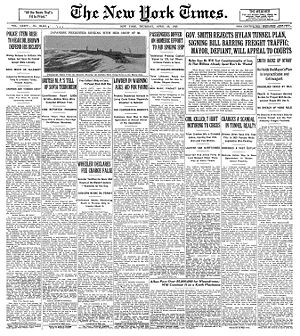Raifuku Maru
Raifuku Maru, a Japanese freighter ship that allegedly "vanished" during a voyage from Boston to Hamburg, Germany, with a cargo of wheat and a crew of thirty-eight, in April 1925 (some reports erroneously say 1921 or 1924). This case is usually cited as a part of the Bermuda Triangle mystery, but in reality there has been proven to be a much more mundane explanation.
The “Disappearance”
According to the popular story, the RMS Homeric, a vessel of the White Star Line, received a cryptic SOS from the Raifuku Maru on April 21st, 1925, which read, in broken English: “Danger like a dagger now! Come quick!” Reportedly, the Homeric traveled to where the vessel had given the SOS, but found not a trace of the ship. There was much speculation over what the “dagger” was (popular opinion seems to be divided between waterspouts and UFOs), and this was regarded as a genuine mystery of the sea by many. Popular writers on the Bermuda Triangle, specifically Charles Berlitz and Vincent Gaddis, propagated the myth of the vessel’s “mysterious” sinking, and it entered the lexicon along with such other well-known incidents as the Mary Celeste, the Carroll A. Deering, and Flight 19.
Explanation
However, there has been proven to be a much more rational explanation of the mystery. The Raifuku Maru had sailed out of Boston on April 18th, into a heavy storm. The Homeric and several other vessels received the following communication from the Japanese ship’s wireless operator, Masao Hiwatari: “Now very danger! Come quick!” Despite the broken English of the Japanese crewmen, it was obvious that the vessel was in trouble. The Homeric (along with the British vessel King Alexander) tried desperately to reach the Raifuku Maru, but was unable to get close enough to rescue any crew due to the rough seas. The vessel was listing at a 30-degree angle, and sunk with all hands while the Homeric watched. The Homeric sent the following message to the Camperdown Coast Guard station: “OBSERVED STEAMER RAIFUKU MARU SINK IN LAT 4143N LONG 6139W REGRET UNABLE TO SAVE ANY LIVES.” Several vessels attempted to locate bodies or survivors from the ship in the days after the sinking, but found none.
The incident was quite controversial at the time; the Japanese government accused the English captains of racism for not saving their crewmen, though this accusation was unfounded.
Conclusion
It is very interesting in the eyes of skeptics of the Bermuda Triangle phenomenon that such a mundane story was spun off into one of the great mysteries of the sea. It is unclear who the first author to mention the Raifuku Maru in a mysterious context was, though Vincent Gaddis’s Invisible Horizons (1965) was the first popular book to feature the story. Many other books and articles on the Triangle have repeated the story almost verbatim, though as mentioned above the date of the vessel’s sinking seemed to vary from author to author. Larry Kusche, in his Bermuda Triangle Mystery: Solved (1975), pointed out this case as being nothing more than the routine sinking of a merchant vessel, blown up (perhaps by the frantic final message of the wireless operator) into a mysterious incident with possibly supernatural overtones, its place in history being cemented by continual repetition by various credulous authors.
Newspaper References
- “Japanese Ships Sinks With A Crew Of 38; Liners Unable To Aid,” New York Times, April 22, 1925.
- “Passengers Differ On Homeric Effort To Save Sinking Ship,” New York Times, April 23, 1925.
- “Homeric Captain Upheld By Skippers,” New York Times, April 24, 1925.
- “Liner Is Battered In Rescue Attempt,” New York Times, April 25, 1925.
External links
An excellent, in-depth online account of the attempts to rescue the Raifuku Maru and its crew members can be found at: [1]

